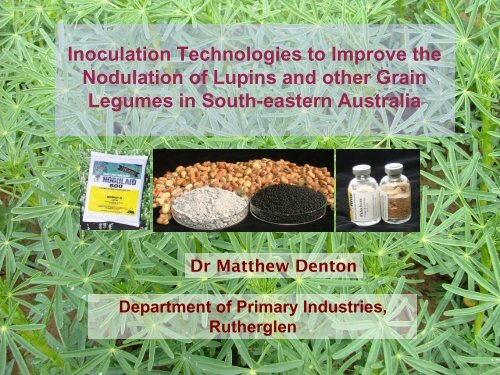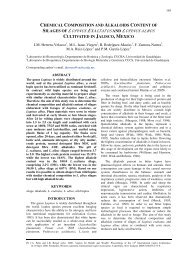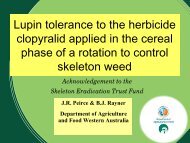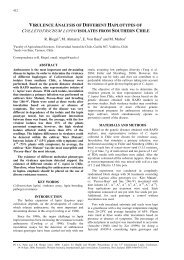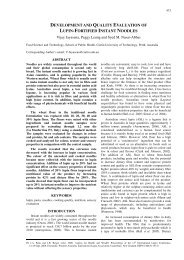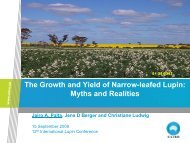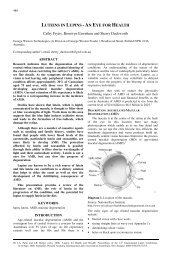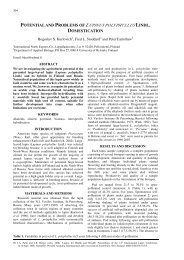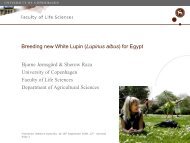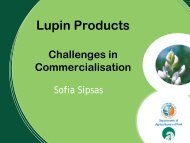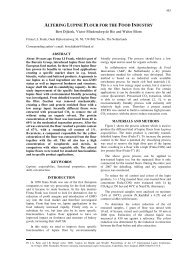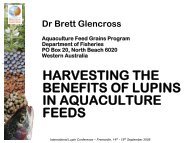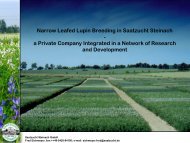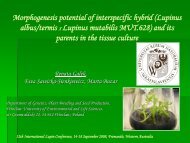Inoculation Technologies to Improve the Nodulation of ... - Lupins.org
Inoculation Technologies to Improve the Nodulation of ... - Lupins.org
Inoculation Technologies to Improve the Nodulation of ... - Lupins.org
Create successful ePaper yourself
Turn your PDF publications into a flip-book with our unique Google optimized e-Paper software.
DEPARTMENT OF<br />
PRIMARY INDUSTRIES<br />
<strong>Inoculation</strong> <strong>Technologies</strong> <strong>to</strong> <strong>Improve</strong> <strong>the</strong><br />
<strong>Nodulation</strong> <strong>of</strong> <strong>Lupins</strong> and o<strong>the</strong>r Grain<br />
Legumes in South-eastern Australia<br />
Dr Mat<strong>the</strong>w Den<strong>to</strong>n<br />
Department <strong>of</strong> Primary Industries,<br />
Ru<strong>the</strong>rglen
DEPARTMENT OF<br />
PRIMARY INDUSTRIES<br />
Outline<br />
• The importance <strong>of</strong> legumes <strong>to</strong> farming systems<br />
• Inoculant types in <strong>the</strong> Australian system<br />
• Efficacy <strong>of</strong> liquid and granular inoculants<br />
• Potential advantages <strong>of</strong> soil-applied inoculants<br />
2
DEPARTMENT OF<br />
PRIMARY INDUSTRIES<br />
Australian agriculture is highly<br />
reliant on nitrogen inputs<br />
Nitrogen fertilisers - <strong>the</strong><br />
single most energy<br />
expensive input in<br />
agriculture<br />
accounts for 35-68% <strong>of</strong><br />
<strong>to</strong>tal on-farm energy<br />
use<br />
Chen et al. 2008 Aust J Soil Res 46, 289-301
DEPARTMENT OF<br />
PRIMARY INDUSTRIES<br />
Energy Efficiency <strong>of</strong> Fertiliser vs Legume N<br />
Energy intensive<br />
30 GJ t - 1 NH 3<br />
4 kg CO 2 emitted / kg<br />
N produced<br />
Pho<strong>to</strong>syn<strong>the</strong>tically-<br />
driven N fertiliser<br />
Effectively no CO 2<br />
emission
DEPARTMENT OF<br />
PRIMARY INDUSTRIES<br />
N provided by lupins<br />
Crop type<br />
Mean N<br />
balance<br />
(kg N/ha)<br />
Range<br />
(kg N/ha)<br />
Ref<br />
Lupin 88 70-107 Evans 2001<br />
Lupin 78 (-29) -247 Evans 1987,<br />
1989<br />
Lupin 97 174-177 Rochester<br />
1998<br />
Lupin 65 32 - 96 Unkovich<br />
1994<br />
• In addition, 30% <strong>of</strong> Total plant N is BG at harvest<br />
McNeill et al. 2008 Plant & Soil, 302:297-
DEPARTMENT OF<br />
PRIMARY INDUSTRIES<br />
Peat Inoculants<br />
• Industry standard<br />
for Australia<br />
• High quality<br />
• >10 9 cells g -1 peat<br />
• Applied as a slurry<br />
or a liquid
DEPARTMENT OF<br />
PRIMARY INDUSTRIES<br />
Granular Inoculants<br />
Granular inoculants<br />
• Introduced in<strong>to</strong> <strong>the</strong> Australian market for ~5 years<br />
• Carriers: peat, or clays (usually ben<strong>to</strong>nite, attapulgite<br />
• Non-sterile formulations (unlike peat slurries)
DEPARTMENT OF<br />
PRIMARY INDUSTRIES<br />
Freeze-dried inoculants<br />
Applied as:<br />
1) slurry <strong>to</strong><br />
seed, or<br />
2) liquid in<strong>to</strong><br />
furrows
DEPARTMENT OF<br />
PRIMARY INDUSTRIES<br />
How do granular and liquid<br />
inoculants differ <strong>to</strong> peat slurries?<br />
• Peat slurry inoculants are applied <strong>to</strong> SEED<br />
• Granules and liquid inoculants are applied <strong>to</strong> SOIL<br />
• Soil inoculation:<br />
1. Avoids incompatibility with seed <strong>to</strong>xins (fungicides, insecticides)<br />
2. Avoids <strong>the</strong> need <strong>to</strong> inoculate seed<br />
3. No time dependency when unfavourable conditions disrupt<br />
sowing<br />
4. Potential for dry sowing conditions<br />
9
DEPARTMENT OF<br />
PRIMARY INDUSTRIES<br />
Seed inoculation Soil inoculation<br />
Peat inoculant<br />
on <strong>the</strong> seed<br />
Granular<br />
inoculant in<br />
<strong>the</strong> seed row<br />
Few large nodules<br />
close <strong>to</strong> <strong>the</strong> crown<br />
Several medium<br />
nodules on<br />
crown and<br />
lateral roots<br />
Slide courtesy <strong>of</strong> New<strong>to</strong>n Lupwayi
DEPARTMENT OF<br />
PRIMARY INDUSTRIES<br />
Chickpeas (Kyei-Boahen et al., 2001)<br />
Treatment<br />
Nodule dry weight (mg/plant)<br />
Crown Lateral Total<br />
Control 0.0 3.0 3.0<br />
Liquid 9.5 16.0 25.5<br />
Peat 193.3 70.8 264.0<br />
Granular 80.3 163.0 243.3<br />
Slide courtesy <strong>of</strong> New<strong>to</strong>n Lupwayi
DEPARTMENT OF<br />
PRIMARY INDUSTRIES<br />
Chickpeas (Kyei-Boahen et al., 2001)<br />
Treatment %Ndfa Grain yield<br />
(t/ha)<br />
Control 17.2 1.22<br />
Liquid 19.9 1.52<br />
Peat 49.1 1.81<br />
Granular 56.9 1.81<br />
Slide courtesy <strong>of</strong> New<strong>to</strong>n Lupwayi
DEPARTMENT OF<br />
PRIMARY INDUSTRIES<br />
What is <strong>the</strong> efficacy <strong>of</strong> granular and<br />
liquid inoculants in Australia?<br />
•37 experiments over 5 years in Vic, SA and<br />
sou<strong>the</strong>rn NSW<br />
•Efficacy <strong>of</strong> granular and liquid inoculants tested<br />
•<strong>Lupins</strong>, faba beans, peas, chickpeas and lentils<br />
13
DEPARTMENT OF<br />
PRIMARY INDUSTRIES<br />
Site distribution
DEPARTMENT OF<br />
PRIMARY INDUSTRIES<br />
What difference does soil<br />
inoculation make?<br />
15
DEPARTMENT OF<br />
PRIMARY INDUSTRIES<br />
Crown nodulation,<br />
typical <strong>of</strong> peat slurry<br />
inoculants<br />
Crown and Deep<br />
nodules from effective<br />
granular and liquid<br />
inoculants<br />
10 mm<br />
Chickpeas, Inverleigh, 2007
17<br />
Liquid inoculant seed<br />
Liquid injection<br />
DEPARTMENT OF<br />
PRIMARY INDUSTRIES<br />
Nodule number<br />
18<br />
15<br />
12<br />
9<br />
6<br />
3<br />
Nodule number (plant -1 )<br />
Uninoculated<br />
Peat inoculant<br />
Granules B 5<br />
Granules B 10<br />
Granules B 10 Undersown<br />
Granules A 5<br />
Granules A 10<br />
Granules A 10 Undersown<br />
0<br />
<strong>Lupins</strong>, Inverleigh 2006<br />
Den<strong>to</strong>n, Pearce et al. in prep.
WU425 peat slurry<br />
WU425 water inject<br />
DEPARTMENT OF<br />
PRIMARY INDUSTRIES<br />
Poorly responsive sites<br />
700<br />
600<br />
500<br />
400<br />
300<br />
200<br />
100<br />
Nodule mass (mg per plant)<br />
0<br />
uninoculated<br />
ben<strong>to</strong>nite granules<br />
attapulgite granules<br />
attapulgite granules at 50 mm<br />
Freeze dried on seed<br />
Freeze dried in furrow<br />
80 units N / ha<br />
WSM4024 water inject<br />
WSM4024 peat slurry
DEPARTMENT OF<br />
PRIMARY INDUSTRIES<br />
Response <strong>of</strong> Inoculants<br />
Log<br />
nodulation<br />
(treatments)<br />
Log background nodulation<br />
(nodulation by uninoculated
DEPARTMENT OF<br />
PRIMARY INDUSTRIES<br />
Chickpea Faba bean Lentil Lupin Field pea<br />
Peat slurry<br />
Peat<br />
granules<br />
Attapulgite<br />
granules<br />
Ben<strong>to</strong>nite<br />
granules
DEPARTMENT OF<br />
PRIMARY INDUSTRIES<br />
% Plant nodulation<br />
Data from 37<br />
field trials<br />
separated by<br />
soil rhizobial<br />
population;<br />
black columns<br />
small soil<br />
populations;<br />
white columns<br />
large<br />
populations<br />
100<br />
80<br />
60<br />
40<br />
20<br />
% Plants nodulated<br />
Uninoculated<br />
Ben<strong>to</strong>nite 10 kg / ha<br />
Ben<strong>to</strong>nite 5 kg / ha<br />
Attapulgite 10 kg / ha<br />
Attapulgite 5 kg / ha<br />
Peat granules 10 kg / ha<br />
0<br />
Peat granules 5 kg / ha<br />
Peat slurry on seed
DEPARTMENT OF<br />
PRIMARY INDUSTRIES<br />
Results<br />
(a)<br />
White<br />
symbols –<br />
ben<strong>to</strong>nite<br />
Grey<br />
symbols –<br />
attapulgite<br />
granules<br />
Black<br />
symbols –<br />
peat<br />
granules<br />
% Plant nodulation<br />
100<br />
80<br />
60<br />
40<br />
20<br />
0<br />
10 3 10 4 10 5 10 6 10 7 10 8 10 9 10 10<br />
Rhizobial concentration in granules (number <strong>of</strong> rhizobia g -1 granule)<br />
Den<strong>to</strong>n, Pearce, Ballard, Mutch, Norng, Hannah, Slattery,<br />
unpublished data
DEPARTMENT OF<br />
PRIMARY INDUSTRIES<br />
Results<br />
White<br />
symbols –<br />
ben<strong>to</strong>nite<br />
Grey<br />
symbols –<br />
attapulgite<br />
granules<br />
Black<br />
symbols –<br />
peat<br />
granules<br />
% Plant nodulation<br />
100<br />
80<br />
60<br />
40<br />
20<br />
0<br />
10 3 10 4 10 5 10 6 10 7 10 8 10 9 10 10<br />
Rhizobial concentration in granules (number <strong>of</strong> rhizobia g -1 granule)<br />
(b)<br />
Den<strong>to</strong>n, Pearce, Ballard, Mutch, Norng, Hannah Slattery, unpublished<br />
data
DEPARTMENT OF<br />
PRIMARY INDUSTRIES<br />
Inoculant potential<br />
• Peat inoculant with 10 9 rhizobia applied at<br />
250g / 100 kg seed and sown at 100 kg seed<br />
/ ha = 2.5 x 10 11 rhizobia / ha<br />
• Granular inoculant with 10 7 rhizobia applied<br />
at 10 kg / ha = 1 x 10 11 rhizobia / ha
DEPARTMENT OF<br />
PRIMARY INDUSTRIES<br />
Field Response<br />
Granular<br />
inoculant<br />
Peat<br />
inoculant<br />
Nil<br />
Faba beans, Yalla-Y-Pora, 2005
DEPARTMENT OF<br />
PRIMARY INDUSTRIES Grain yield<br />
3<br />
2<br />
1<br />
Grain yield (<strong>to</strong>nnes ha -1 )<br />
Uninoculated<br />
Peat inoculant<br />
Granules B 5<br />
Granules B 10<br />
Granules B 10 Undersown<br />
Granules A 5<br />
0<br />
Granules A 10<br />
Granules A 10 Undersown<br />
Faba beans, Ararat 2005
DEPARTMENT OF<br />
PRIMARY INDUSTRIES<br />
Grain N<br />
250<br />
Grain nitrogen (kg N ha -1 )<br />
200<br />
150<br />
100<br />
50<br />
0<br />
0 1 2 3 4<br />
Nodule score (plant -1 )<br />
Faba beans, Ararat 2005
DEPARTMENT OF<br />
PRIMARY INDUSTRIES<br />
Conclusions<br />
• Soil inoculants provide an option for inoculation<br />
when seeds contain fungicides / pesticides<br />
• Granular inoculants provide an option for inoculation<br />
in dry soil environments<br />
• Liquid inoculants are as effective as peat slurry<br />
inoculants<br />
• Granular inoculants can be as effective as peat<br />
slurry inoculants, but require >10 7 cells g -1 inoculant
DEPARTMENT OF<br />
PRIMARY INDUSTRIES<br />
Acknowledgments<br />
•The Grains Research and Development Corporation<br />
and DPI for funding this work through <strong>the</strong> National<br />
Rhizobium Program<br />
•Bernadette Carmody and David Pearce - technical<br />
assistance<br />
•Ross Ballard, Lesley Mutch and Jo Slattery -<br />
collabora<strong>to</strong>rs<br />
•Murray Hannah and Sorn Norng - statistical assistance<br />
29


